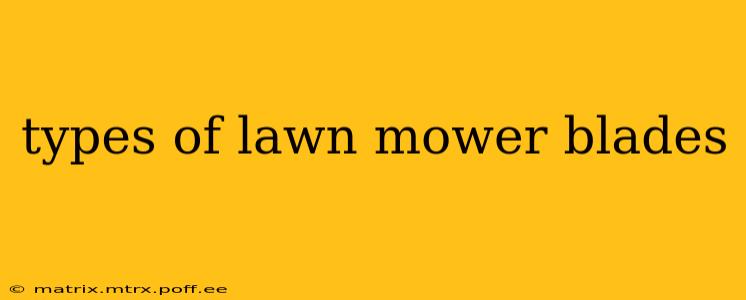Choosing the right lawn mower blade is crucial for achieving a healthy, beautiful lawn. Different blade types are designed for specific tasks and grass types, impacting everything from cutting quality to mulching efficiency. This guide explores the various types of lawn mower blades available, helping you select the perfect one for your needs.
What are the Different Types of Lawn Mower Blades?
Several key types of blades cater to diverse mowing needs. Understanding their differences will significantly impact your lawn's health and appearance.
1. High-Lift Blades
These blades are designed to provide a superior cut, particularly for taller grasses. Their unique design lifts the grass higher before cutting, resulting in a cleaner cut and improved bagging. The high lift action also helps with improved mulching by creating finer clippings. Ideal for: Thick, tall grass, bagging, and mulching.
2. Mulching Blades
Mulching blades feature a series of curved baffles and a specially designed cutting edge. These baffles recut the grass clippings multiple times, creating extremely fine particles that decompose quickly, acting as a natural fertilizer for your lawn. Ideal for: Maintaining a healthy lawn with minimal cleanup, and for lawns where bagging isn't desired. They are not ideal for very long, wet grass.
3. Low-Cut Blades
As their name suggests, low-cut blades are designed for close, precise cuts. They are excellent for maintaining lawns at very low heights, often used for putting greens or highly manicured lawns. The downside is that they might not perform well in taller grass, potentially causing scalping. Ideal for: Very short grass, golf greens, and lawns requiring extremely low maintenance.
4. Gator Blades
Gator blades are characterized by their aggressive, serrated teeth-like design. These blades are exceptionally durable, able to cut through tough weeds and thick grasses with ease. They're also often preferred for tackling overgrown lawns. Ideal for: Overgrown lawns, thick weeds, and tough grasses.
5. Rotary Blades
Rotary blades are the most common type found in rotary mowers. They spin horizontally, cutting grass through a chopping action. While generally effective, the quality of the cut can vary depending on blade sharpness and mower maintenance. Many rotary blades are designed to function with mulching capabilities as well. Ideal for: A wide variety of lawn types and cutting heights, offering a balance between cost and effectiveness.
How Do I Choose the Right Lawn Mower Blade?
Selecting the right blade depends on several factors:
- Grass Type: Thick, coarse grasses require more robust blades like gator blades, while finer grasses may do well with standard rotary blades or low-cut blades.
- Cutting Height: Consider the desired height of your lawn; low-cut blades are for very short grass, while high-lift blades are for taller grass.
- Mulching vs. Bagging: Mulching blades are for those who prefer to recycle grass clippings as fertilizer, while high-lift blades are better for bagging.
- Lawn Condition: For overgrown lawns, gator blades are a better option. For consistently maintained lawns, standard rotary blades or mulching blades may suffice.
What are the Signs My Lawn Mower Blades Need Replacing?
Several indicators signal the need for new blades:
- Uneven Cuts: Jagged, inconsistent cuts are a sign of dull or damaged blades.
- Scalping: If the mower is consistently removing too much grass, the blade might be improperly balanced or damaged.
- Excessive Vibrations: Unbalanced or damaged blades can lead to significant vibrations during mowing.
- Bent or Damaged Blades: Obvious bends, chips, or cracks indicate the need for replacement.
Regular inspection and replacement of your lawn mower blades are essential for maintaining a healthy, beautiful lawn. Remember to always follow safety precautions when handling and replacing blades. Choosing the right blade type for your specific needs will significantly enhance the effectiveness and overall performance of your lawnmower.
